-
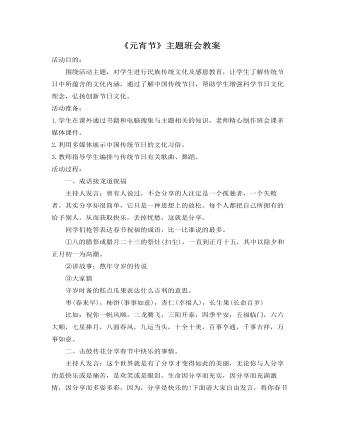
《元宵节》主题班会教案
活动目的: 围绕活动主题,对学生进行民族传统文化及感恩教育,让学生了解传统节日中所蕴含的文化内涵,通过了解中国传统节日,帮助学生增强科学节日文化理念,弘扬创新节日文化。 活动准备: 1.学生在课外通过书籍和电脑搜集与主题相关的知识,老师精心制作班会课多媒体课件。 2.利用多媒体展示中国传统节日的文化习俗。 3.教师指导学生编排与传统节日有关歌曲、舞蹈。 活动过程: 一、成语接龙道祝福 主持人发言:曾有人说过,不会分享的人注定是一个孤独者,一个失败者。其实分享却很简单,它只是一种思想上的放松。每个人都把自己所拥有的给予别人,从而获取快乐,丢掉忧愁,这就是分享。 同学们抢答表达春节祝福的成语,比一比谁说的最多。 ①八的腊祭或腊月二十三的祭灶(扫尘),一直到正月十五,其中以除夕和正月初一为高潮。
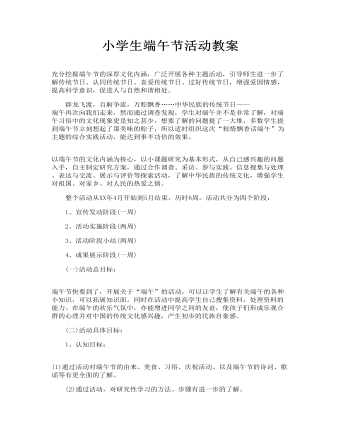
小学生端午节活动教案
群龙飞渡,百舸争流,万粽飘香……中华民族的传统节日——端午再次向我们走来,然而通过调查发现,学生对端午并不是非常了解,对端午习俗中的文化现象更是知之甚少,想要了解的问题提了一大堆,多数学生提到端午节立刻想起了那美味的粽子,所以适时组织这次“粽情飘香话端午”为主题的综合实践活动,能达到事半功倍的效果。 以端午节的文化内涵为核心,以小课题研究为基本形式,从自己感兴趣的问题入手,自主制定研究方案,通过合作调查、采访、参与实践、信息搜集与处理、表达与交流、展示与评价等探索活动,了解中华民族的传统文化,增强学生对祖国、对家乡、对人民的热爱之情。
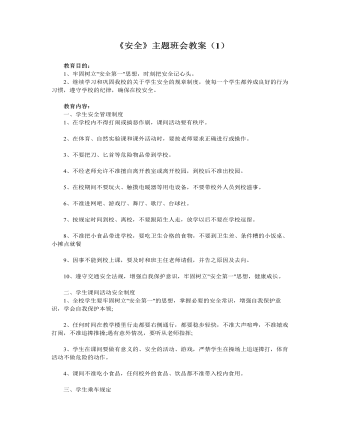
《安全》主题班会教案(1)
教育内容:一、学生安全管理制度1、在学校内不得打闹或搞恶作剧,课间活动要有秩序。2、在体育、自然实验课和课外活动时,要按老师要求正确进行或操作。3、不要把刀、匕首等危险物品带到学校。4、不经老师允许不准擅自离开教室或离开校园,到校后不准出校园。5、在校期间不要玩火、触摸电暖器等用电设备,不要带校外人员到校滋事。6、不准进网吧、游戏厅、舞厅、歌厅、台球社。7、按规定时间到校、离校,不要跟陌生人走,放学以后不要在学校逗留。8、不准把小食品带进学校,要吃卫生合格的食物,不要到卫生差、条件糟的小饭桌、小摊点就餐9、因事不能到校上课,要及时和班主任老师请假,并告之原因及去向。10、遵守交通安全法规,增强自我保护意识,牢固树立"安全第一"思想,健康成长。
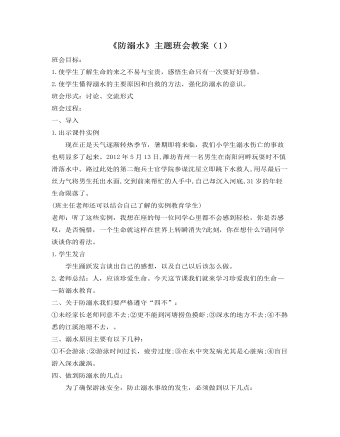
《防溺水》主题班会教案(1)
班会目标: 1.使学生了解生命的来之不易与宝贵,感悟生命只有一次要好好珍惜。 2.使学生懂得溺水的主要原因和自救的方法,强化防溺水的意识。 班会形式:讨论、交流形式 班会过程: 一、导入 1.出示课件实例 现在正是天气逐渐转热季节,暑期即将来临,我们小学生溺水伤亡的事故也明显多了起来。2012年5月13日,潍坊青州一名男生在南阳河畔玩耍时不慎滑落水中。路过此处的第二炮兵士官学院参谋沈星立即跳下水救人,用尽最后一丝力气将男生托出水面,交到前来帮忙的人手中,自己却沉入河底,31岁的年轻生命陨落了。 (班主任老师还可以结合自己了解的实例教育学生) 老师:听了这些实例,我想在座的每一位同学心里都不会感到轻松。你是否感叹,是否惋惜,一个生命就这样在世界上转瞬消失?此刻,你在想什么?请同学谈谈你的看法。
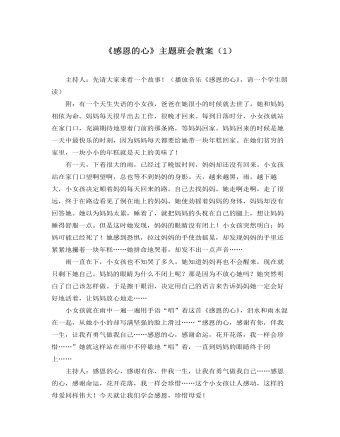
《感恩的心》主题班会教案(1)
主持人:然而我们又是怎样对待我们的父母的呢?下面我们来做个调查?你是否了解你的妈妈?1、你妈妈的生日是_________。2、你妈妈的体重是_________。3、你妈妈的身高是________。4、你妈妈穿_______码鞋。5、你妈妈喜欢颜色是________。6、你妈妈喜欢水果是________。7、你妈妈喜欢的花是________。8、你妈妈喜欢的日常消遣活动是_____________。请你如实回答。把你的答案写在一张纸寄给你妈妈评分答对6题以下的请你以后多与妈妈沟通。主持人:其实值得感恩的不仅仅我们的母亲,我们对父亲、师长、亲朋、同学、社会等等都应始终抱有感恩之心。我们的生命、健康、财富以及我们每天享受着的空气阳光水源,都应该在我们的感恩之列。一位盲人曾经请人在自己的乞讨用的牌子上这样写道:“春天来了,而我却看不到她。”我们与这位盲人相比,进一步说与那些失去生命和自由的人相比,目前能这样快快乐乐地活在世界上,谁说不是一种命运的恩赐,我们还会时常愤怒得发抖而总去抱怨命运给自己的不幸和不平吗?
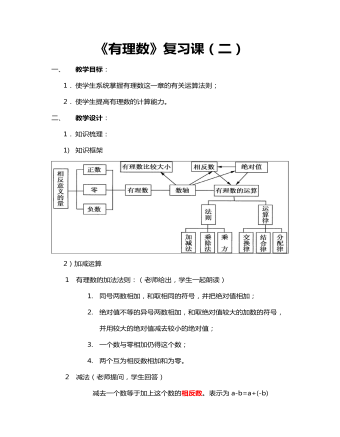
有理数复习教案教学设计
3)乘除运算①有理数的乘法法则:(老师给出,学生一起朗读)1. 两数相乘,同号得正,异号得负,并把绝对值相乘;2. 任何数与零相乘都得零;3. 几个不等于零的数相乘,积的符号由负因数的个数决定,当负因数有奇数个数,积为负;当负因数的个数为偶数个时,积为正;4. 几个有理数相乘,若其中有一个为零,积就为零。②有理数的除法法则:(老师提问,学生回答)1. 两个有理数相除,同号得正,异号得负,并把绝对值相除;2. 除以一个数等于乘以这个数的倒数。③关系(老师给出)除法转化为乘法进行运算。
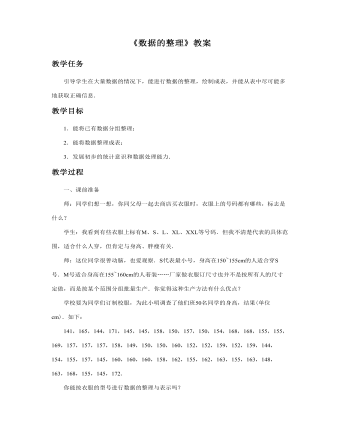
数据的整理教案教学设计
一、课前准备师:同学们想一想,你同父母一起去商店买衣服时,衣服上的号码都有哪些,标志是什么?学生:我看到有些衣服上标有M、S、L、XL、XXL等号码.但我不清楚代表的具体范围,适合什么人穿,但肯定与身高、胖瘦有关.师:这位同学很善动脑,也爱观察.S代表最小号,身高在150~155cm的人适合穿S号.M号适合身高在155~160cm的人着装……厂家做衣服订尺寸也并不是按所有人的尺寸定做,而是按某个范围分组批量生产.你觉得这种生产方法有什么优点?学校要为同学们订制校服,为此小明调查了他们班50名同学的身高,结果(单位cm).如下
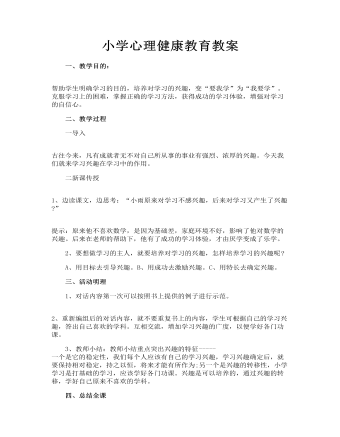
小学心理健康教育教案
二、教学过程 一导入 古往今来,凡有成就者无不对自己所从事的事业有强烈、浓厚的兴趣。今天我们就来学习兴趣在学习中的作用。 二新课传授 1、边读课文,边思考:“小雨原来对学习不感兴趣,后来对学习又产生了兴趣?” 提示:原来他不喜欢数学,是因为基础差,家庭环境不好,影响了他对数学的兴趣。后来在老师的帮助下,他有了成功的学习体验,才由厌学变成了乐学。 2、要想做学习的主人,就要培养对学习的兴趣,怎样培养学习的兴趣呢? A、用目标去引导兴趣。B、用成功去激励兴趣。C、用特长去确定兴趣。
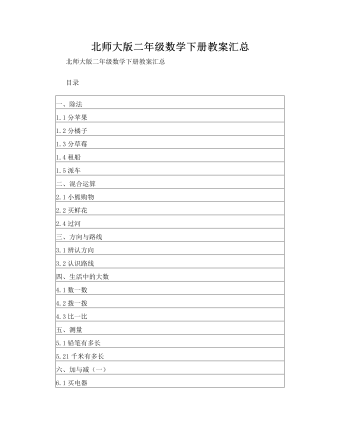
二年级数学下册教案汇总
教学反思:1、引导学生体验抽象除法竖式的过程。学生在学习表内乘除法时,利用乘法口诀已经能够在算式上直接写出得数。教材安排了“18个苹果,每盘放6个,可以放几盘”的“分苹果”活动,列举了四种解决这一问题的方法。在此基础上,引导学生按照自己的想法来分这些苹果,进而再由对除法竖式有一定了解的学生介绍竖式计算,并且把竖式中的每一步所表示的含义和分苹果的活动紧密联系起来。2、在探究中理解除法的试商方法。学生通过实际操作、观察比较,培养学生质疑和创新精神,学会学习、积累数学活动经验的有意义的学习过程。3、不足:这节课上得不够生动、活泼。
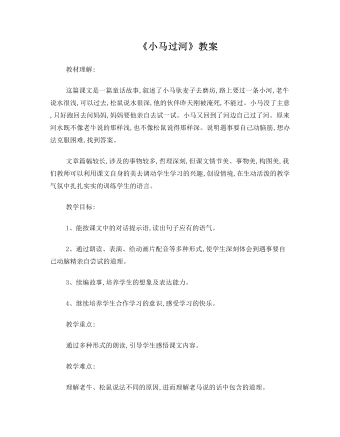
二年级语文小马过河教案
这篇课文是一篇童话故事,叙述了小马驮麦子去磨坊,路上要过一条小河,老牛说水很浅,可以过去,松鼠说水很深,他的伙伴昨天刚被淹死,不能过。小马没了主意,只好跑回去问妈妈,妈妈要他亲自去试一试。小马又回到了河边自己过了河。原来河水既不像老牛说的那样浅,也不像松鼠说得那样深。说明遇事要自己动脑筋,想办法克服困难,找到答案。文章篇幅较长,涉及的事物较多,哲理深刻,但课文情节美、事物美,构图美,我们教师可以利用课文自身的美去调动学生学习的兴趣,创设情境,在生动活泼的教学气氛中扎扎实实的训练学生的语言。
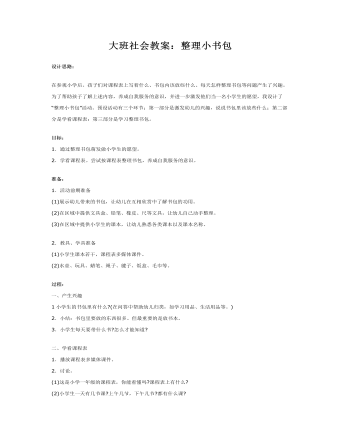
大班社会教案:整理小书包
目标:1.通过整理书包萌发做小学生的愿望。2.学看课程表。尝试按课程表整理书包,养成自我服务的意识。准备:1.活动前期准备(1)展示幼儿带来的书包,让幼儿在互相欣赏中了解书包的功用。(2)在区域中提供文具盒、铅笔、橡皮、尺等文具,让幼儿自己动手整理。(3)在区域中提供小学生的课本,让幼儿熟悉各类课本以及课本名称。2.教具、学具准备(1)小学生课本若干,课程表多媒体课件。(2)水壶、玩具、蜡笔、绳子、毽子、饭盒、毛巾等。
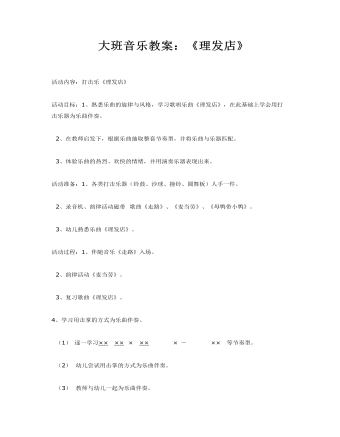
大班音乐教案:《理发店》
2、在教师启发下,根据乐曲抽取整套节奏型,并将乐曲与乐器匹配。 3、体验乐曲的热烈、欢快的情绪,并用演奏乐器表现出来。活动准备:1、各类打击乐器(铃鼓、沙球、撞铃、圆舞板)人手一件。 2、录音机、韵律活动磁带 歌曲《走路》、《麦当劳》、《母鸭带小鸭》。 3、幼儿熟悉乐曲《理发店》。 活动过程:1、伴随音乐《走路》入场。 2、韵律活动《麦当劳》。 3、复习歌曲《理发店》。
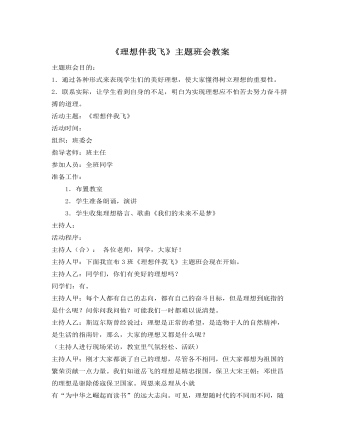
《理想伴我飞》主题班会教案
主持人甲:听完这几则名人的故事,我们会发现:树立了远大理想的人,就意味着事业成功了一半。无志之人,不可能激起生活的浪花;无志之人,不可能享受事业的种种辉煌。 主持人乙:当今世界已步入知识经济时代,没有知识必将被社会洪流无情淘汰,更谈不上在21世纪立足。回过头来,看看自己,作为世纪之交的毕业生,21世纪祖国建设的主力军,我们今天有什么理想和抱负呢?勇敢的你,站到前面来,把你的雄心壮志说出来,把你装着理想的纸鹤飞到我们的理想旗帜中。这是你实现理想的第一步,就是你有巨大的勇气。 主持人甲:我们知道,理想的实现并不容易。 主持人乙:我们明白,理想的实现需要辛勤的汗水。 合:我们都会付出我们的勤劳,实现我们从小立下的志向。 主持人甲:不知20年后的你是什么样子,我又是什么样子。现在请大家来看看20年后的我们。
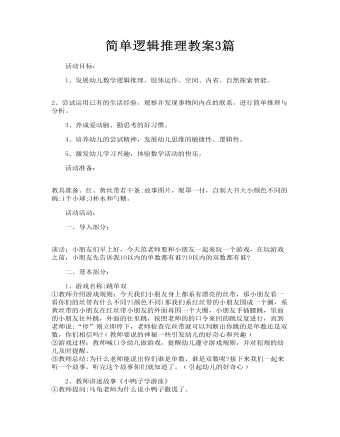
简单逻辑推理教案3篇
一、导入部分: 谈话:小朋友们早上好,今天范老师要和小朋友一起来玩一个游戏,在玩游戏之前,小朋友先告诉我10以内的单数都有谁?10以内的双数都有谁? 二、基本部分: 1、游戏名称:跳单双 ①教师介绍游戏规则:今天我们小朋友身上都系有漂亮的丝带,那小朋友看一看你们的丝带有什么不同?(颜色不同)那我们系红丝带的小朋友围成一个圈,系黄丝带的小朋友在红丝带小朋友的外面再围一个大圈,小朋友手插腰跳,里面的小朋友往外跳,外面的往里跳,按照老师的的口令来回的跳反复进行,直到老师说:“停”则立即停下,老师检查完丝带就可以判断出你跳的是单数还是双数,你们相信吗?﹙教师要说的神秘一些引发幼儿的好奇心和兴趣﹚②游戏过程:教师喊口令幼儿做游戏,提醒幼儿遵守游戏规则,并对犯规的幼儿及时提醒。 ③教师总结:为什么老师能说出你们谁是单数,谁是双数呢?接下来我们一起来听一个故事,听完这个故事你们就知道了。﹙引起幼儿的好奇心﹚
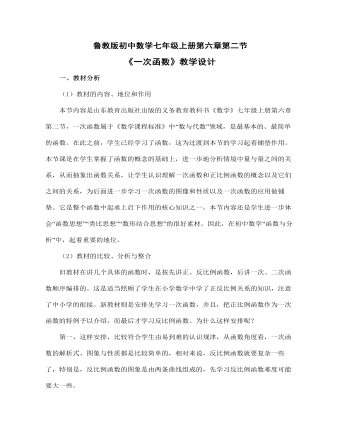
一次函数教学教案
教学目标1.能从实际问题中得到函数关系式,学会积累函数的建模思想;2.能对不同背景下函数模型(关系式)的比较,抽象出一次函数和正比例函数的概念,发展抽象思维及概括能力;3.初步理解一次函数与正比例函数的概念;4.知道一次函数与正比例函数的联系和区别,体验特殊和一般的辩证关系;5.会判断两个变量之间的关系是一次函数还是正比例函数;6.能根据问题信息,确定一次函数与正比例函数的表达式,提升数学应用能力;7.会根据一次函数与正比例函数的概念,求字母的取值;8.在一次函数和正比例函数概念的形成与应用过程中, 体验函数与人类生活的密切联系,增强对函数学习的求知。感受合作交流的必要性,同时提高学生的观察、抽象、概括的能力和语言表达能力,从而培养学生对学习数学的兴趣。
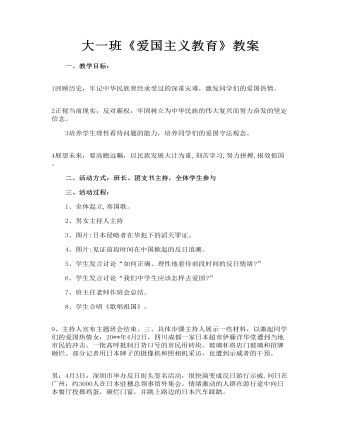
大一班《爱国主义教育》教案
二、活动方式:班长、团支书主持,全体学生参与 三、活动过程: 1、全体起立,奏国歌。 2、男女主持人主持 3、图片:日本侵略者在华犯下的滔天罪证。 4、图片:见证前段时间在中国掀起的反日浪潮。 5、学生发言讨论“如何正确、理性地看待前段时间的反日情绪?” 6、学生发言讨论“我们中学生应该怎样去爱国?” 7、班主任老师作班会总结。 8、学生合唱《歌唱祖国》。

一年级数学下册教案
教学目标:1、通过观察实物,体会到从不同角度观察物体所看到的形状可能是不同的。2、会辨认简单物体从不同角度观察到的形状,发展空间观念。教学重点:会辨认简单物体从不同角度观察到的形状。教学难点:体会到从不同角度观察到的的形状可能是不同的,发展空间观念。课前准备:实物或图片等教学过程:一、出示玩具汽车,学会观察物体第一步:1、观察玩具汽车,学生分别站在汽车侧面和后面两个不同的方向观察。2、分别把玩具汽车的侧面和后面对着全班,让学生说一说这是谁看到的?3、小结:不同的位置观察同一物时,看到的形状可能是不同的。
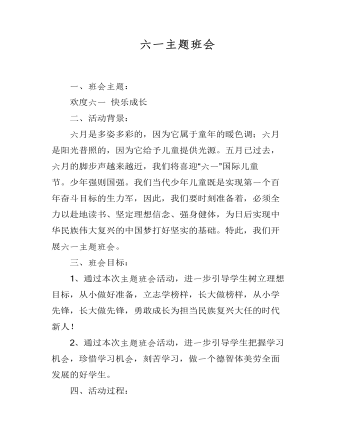
六一主题班会教案
三、班会目标:1、通过本次主题班会活动,进一步引导学生树立理想目标,从小做好准备,立志学榜样,长大做榜样,从小学先锋,长大做先锋,勇敢成长为担当民族复兴大任的时代新人!2、通过本次主题班会活动,进一步引导学生把握学习机会,珍惜学习机会,刻苦学习,做一个德智体美劳全面发展的好学生。
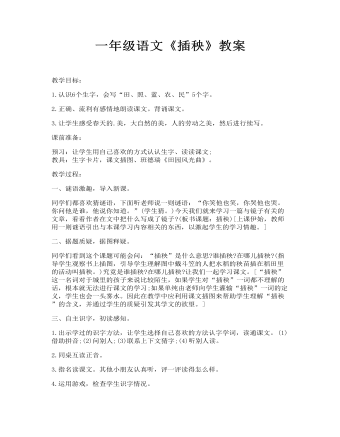
一年级语文《插秧》教案
一、谜语激趣,导入新课。同学们都喜欢猜谜语,下面听老师说一则谜语:“你笑他也笑,你哭他也哭。你问他是谁,他说你知道。”(学生猜。)今天我们就来学习一篇与镜子有关的文章,看看作者在文中把什么写成了镜子?(板书课题:插秧)[上课伊始,教师用一则谜语引出与本课学习内容相关的东西,以激起学生的学习情趣。]二、据题质疑,据图释疑。同学们看到这个课题可能会问:“插秧”是什么意思?谁插秧?在哪儿插秧?(指导学生观察书上插图,引导学生理解图中戴斗笠的人把水稻的秧苗插在稻田里的活动叫插秧。)究竟是谁插秧?在哪儿插秧?让我们一起学习课文。[“插秧”这一名词对于城里的孩子来说比较陌生,如果学生对“插秧”一词都不理解的话,根本就无法进行课文的学习;如果单纯由老师向学生灌输“插秧”一词的定义,学生也会一头雾水。因此在教学中应利用课文插图来帮助学生理解“插秧”的含义,并通过学生的质疑引发其学文的欲望。]
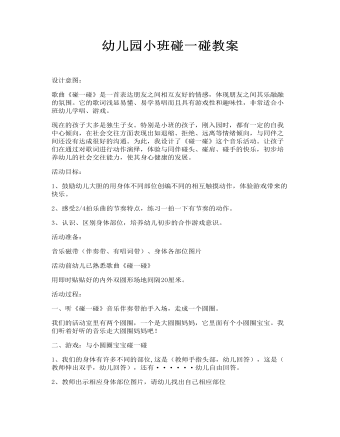
幼儿园小班碰一碰教案.
1、鼓励幼儿大胆的用身体不同部位创编不同的相互触摸动作,体验游戏带来的快乐。2、感受2/4拍乐曲的节奏特点,练习一拍一下有节奏的动作。3、认识、区别身体部位,培养幼儿初步的合作游戏意识。活动准备:音乐磁带(伴奏带、有唱词带)、身体各部位图片活动前幼儿已熟悉歌曲《碰一碰》用即时贴贴好的内外双圆形场地间隔20厘米。

